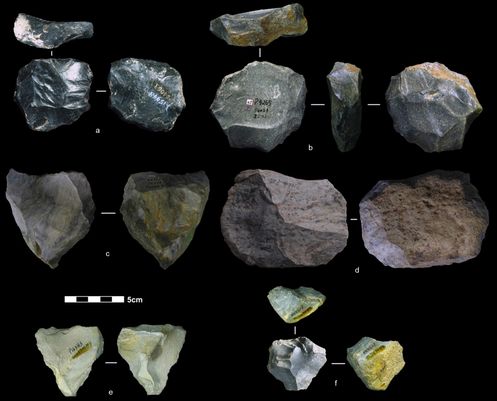
Forget clubs. Real “cave men” in China actually used complex tools as far back as 170,000 years ago, a new study says.
The ancient artefacts recently found at an archaeological site in China show that the relatively sophisticated tool technology emerged in East Asia much earlier than previously thought, challenging the idea that such advanced tool-making was introduced into Asia from the west.
Previously, archaeological records in China had suggested a jump from relatively primitive tools to relatively advanced ones, leading to the suggestion that the more advanced techniques had arrived via migration.
However, analyses of 2,273 stone artefacts from China’s Guanyindong Cave revealed 45 examples of so-called “mode III” craftsmanship – the transitional phase between the various techniques. Light-dating techniques aged them at 80,000 to 170,000 years old, or contemporary to mode III technology in the west.
Such tools – dubbed the “Swiss Army knife” of prehistoric tools – were efficient and durable, indispensable to a hunter-gatherer society in which a broken spear point could mean certain death at the claws or jaws of a predator.
The mode III tools are known as “Levallois” cores, named after a Paris suburb where tools made with this method were first discovered. “To our knowledge, this is the earliest evidence of Levallois technology in east Asia,” the study said.
Made by chipping flakes off a stone so that the flakes themselves become the tools, Levallois tools are considered to be a “middle stage” in the development of stone tool technology, Archaeology magazine reported.
These tools are the result of a set of very specific steps of chipping a piece of stone to create similar-size tools suitable to be shaped for a variety of purposes, according to Smithsonian magazine.
“It used to be thought that Levallois cores came to China relatively recently with modern humans,” said Ben Marwick, an University of Washington anthropologist and one of the study’s co-authors, in a statement. “Our work reveals the complexity and adaptability of people there that is equivalent to elsewhere in the world. It shows the diversity of the human experience.”
Several different species of humans lived on Earth at this time, including modern ones like us, according to the Smithsonian. But scientists haven’t found any human bones from where these tools were discovered, so they don’t know which species of human made these tools.
“Hopefully our study will lead to new excavations and more detailed studies in this region,” said study co-author Bo Li of Australia’s University of Wollongong in a statement. “There are many caves in this region that are perfect for the preservation of tools and fossils, but there haven’t been many digs.
“If we can find a human fossil – or the fossil of a different species – then we can then understand more about who made these tools and what the origin of the technique is,” Li said.
The study was published Monday in the peer-reviewed British journal Nature.













